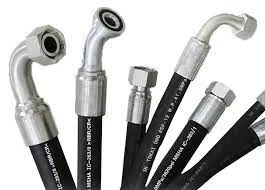Having a few questions about hydraulic hoses? You're not alone. In this article, we cover the Requirements, Types, Dimensions, and Chemical Resistance. Then, learn how to make hydraulic hoses to fit your specific needs. You'll also learn how to make your own hoses, which will save you a lot of money and time. Then, learn how to install them correctly.
Requirements
Identifying a hose's layline is critical for determining the appropriate hose for your application. The layline should contain information such as the inside diameter, pressure rating, and size. The manufacturer, model name, and the size of the hose are also important. These details may vary, but will determine how the hose will be used and what its potential for damage is. Listed below are some of the most common hose specifications.
The length of the hose is another critical consideration. It must be long enough to achieve the right bend radius. The hose should be long enough to account for expansion, which may occur during the pressurizing process. The hose's length can increase by 2% to 4%, which means a 24" hose can actually change by an inch in length. For this reason, the hose must be cut at least an inch longer than it needs to be.
Types
There are three main types of hydraulic hoses: inner, intermediate, and outer. The inner layer contains the fluid and is usually the thinnest and most flexible. The middle layer is reinforced by a fabric or coiled cord that adds flexibility and protects it from sharp objects and extreme weather conditions. The outer layer protects the hose from harsh conditions, such as extreme temperatures, sharp objects, and chemicals. The fittings on hydraulic hoses must also withstand high pressure.
Low-pressure hoses are available in two basic types: textile-braided hoses and steel wire-braided hosings. Low-pressure hoses are flexible, but not as durable as their higher-pressure counterparts. These are commonly used in mining, oil and gas industries, and construction. Thermoplastic hoses are also highly durable and are used in cold temperatures and heavy-duty applications.
Dimensions
Many people overlook the importance of the dimensions of hydraulic hoses. The length of the hose can be more important than they may think. A longer hose will increase the possibility of pressure drops, as fluid will come in contact with interior walls of the hose and create friction. Hoses must be sturdy to handle the pressure variations. Some may be used in harsh environments, requiring greater resistance than normal. Considering these factors, a hydraulic hose should be measured and ordered accordingly.
The size of the hoses should be chosen carefully to match the requirements of the machine. A hose with a diameter of at least 5/8" will be able to carry a 16-gallons-per-minute (GPM) flow rate. The flow velocity must be at least 20 feet per second in order to prevent leakage of fluid. A hose of higher ID should be used when the flow rate is lower than the specified limit.
Chemical resistance
To determine the chemical resistance of hydraulic hoses, check the tables below. You can use these to identify which material is appropriate for the application. The Chemical Resistance Table also contains information on the abrasion and UV resistance of the hoses. The hoses come in pre-cut lengths of one, three, and ten meters, and in rolls of 50 meters. The tables are intended to be used as a guide only, and they are not comprehensive.
The selection of the hose should be made according to the type of fluid that it is carrying. A hydraulic hose is generally suitable for transporting petroleum oils and liquids with a high water content, while liquids containing synthetic oil need a special hose. Chemical resistance increases with higher temperatures. A compound that is suitable at room temperature can quickly degrade at higher temperatures. For this reason, the temperature of hydraulic hoses should be kept within their operating range.
Care
When it comes to maintaining your hydraulic hose, it is important to take care. You should prevent wear and tear by implementing routine maintenance. Hoses often undergo repeated cyclical motions and should be cleaned and inspected on a regular basis. Excessive exposure to UV rays and moisture will corrode metal wires and cause erosion. Rusty steel wire reinforcement can also damage the hose. Hose assemblies are usually made to last a certain number of cycles in your system. You should replace the hose clamps or brackets if they fail to meet these specifications.
When you are making hydraulic hoses, you should take care to ensure that you do not make mistakes that can lead to leakage and failure. You should always check for cracks and leaks, which are likely to signal a leaking hydraulic hose. It is also important to maintain the integrity of the hose by checking the insides. In case of a leak, you should take action immediately. Careful installation is vital to prevent catastrophic failure of the hose.
Identifying hoses in need of repair
In addition to routine inspections, identifying hydraulic hoses in need of repair will enable you to identify problems before they become catastrophic. Look for cracking, bubbles, or blisters, which are all signs that the hose needs to be replaced. Unfortunately, many users neglect to notice these symptoms and continue to operate their equipment with worn hoses. Just like you wouldn't drive your car with a worn tire, you should do the same with your hydraulic hoses.
A leak can cause a hose to swell and lose its internal diameter. A reinforced hose will prevent this swelling, but it can still compromise its integrity. Additionally, incompatible materials can weaken a hose. If a hose becomes too swollen, it could degrade rapidly and lose its flexibility. A leak can cause the hose to pull apart internally, eventually blowing off. If you suspect a hose is in need of repair, perform a pressure test to identify any potential problems before they become critical.
0


